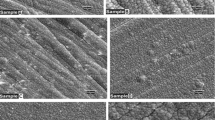Abstract
Binary alloys of niobium with tin, lead, and cadmium are fabricated by the deposition of nanosized metal particles atomized in low-pressure plasma using the thermal-fluctuation melting effect. This effect implies the residence of a small particle in a quasi-liquid state to a certain critical size which, if is exceeded due to vapor condensation or merging (coalescence) with other quasi-liquid particles, leads to the droplet crystallization. Critical sizes are found at which the particles situated in a quasi-liquid state are able to coalescence and formation the alloy–solid solution. They are 2.1–2.2 nm for Nb, 0.4 nm for Sn, 0.6 nm for Pb, and 3.2 nm for Cd. The occurrence boundary of solid solutions of metals in niobium is determined by the following concentrations, at %: Sn 25.5, Pb 23.0, and Cd 64.5. The solid solution is based on the crystal lattice of matrix metal—niobium, in which lead, cadmium, and tin atoms are arranged. In connection with the fact that the sizes of atoms of incorporated metals differ from these for matrix niobium, the lattice parameters of the matrix (Nb) change and additional stresses appear in it up to the lattice destruction. The parameters of the bcc lattice of solid solutions increase with an increase in concentrations of Pb, Cd, and Sn in connection with their atomic sizes more when compared with niobium. The change in the growth rate of the crystal lattice is caused by the change in the schematic of the arrangement of impurity atoms in the matrix niobium lattice for alloys with lead and cadmium. Based on the critical particle sizes of metals, the magnitudes of the surface tension at the crystal–melt boundary are evaluated. They are as follows, J/m2: 1.17–1.22 for Nb, 1.15 × 10–2 for Sn, 1.48 × 10–2 for Pb, and 0.142 for Cd. The fabrication of alloys of refractory niobium with tin, lead, and cadmium is an example of using the size effect when fabricating new materials.




Similar content being viewed by others
REFERENCES
Vekshinskii, S.A., Novyi metod metallograficheskogo issledovaniya splavov (New Method for Metallorgraphic Study of Alloys), Moscow: Ogiz-Gostekhizdat, 1944.
Zhdanov, G.S. and Vertsner, V.N., Direct observation of condensation and crystallization of mercury, Fiz. Tverd. Tela, 1966, vol. 8, no. 4, pp. 1021–1027.
Peppiatt, S.J., The melting of small particles. II. Bismuth, Proc. Royal Soc. A. London, 1975, vol. A345, no. 1642, pp. 401–402.
Berty, J., David, M.J., and Lafourcade, L., Etude de la surfusion de films mines de bismuth par diffracyon des electrons, Thin Solid Films, 1977, vol. 46, no. 2, pp. 177–185.
Zhdanov, G.S., Temperature hysteresis of the phase transition and the mechanism of crystallization of thin metal films, Fiz. Tverd. Tela, 1977, vol. 19, no. 1, pp. 299–301.
Ovsienko, D.E., Maslov, V.V., and Kostyuchenko, V.P., Supercooling of nickel and cobalt in small volumes, Kristallografiya, 1971, vol. 16, no. 2, pp. 405–407.
Buffat, Ph. and Borel, J.-P., Size effect on the melting temperature of gold particles, Phys. Rev. A, 1976, vol. 13, no. 6, pp. 2287–2298.
Perepezko, J.H. and Rasmussen, D.H., Solidification of highly supercooled liquid metal and alloys, J. Non-Cryst. Solids, 1993, vols. 156–158, pp. 463–472.
Roduner, E., Size matters: why nanomaterials are different, Chem. Soc. Rev., 2006, vol. 35, pp. 583–592.
Zou, C., Gao, Y., Yang, B., and Zhai, Q., Size dependent melting properties of Sn nanoparticles by chemical reduction synthesis, Trans. Nonfer. Met. Soc. China, 2010, vol. 20, no. 2, pp. 248–253.
Jiang, H., Moon, K., and Dong, H., Size dependent melting properties of tin nanoparticles, Chem. Phys. Lett., 2006, vol. 429, no. 4, pp. 492–496.
Stowell, M.J., The solid-liquid interfacial free energy of lead from supercooling data, J. Theor. Exp. Appl. Phys., 1970, vol. 22, no. 176, pp. 1–6.
Qingshan, F., Yongqiang, X., and Zixiang, C., Size- and shape-dependent surface thermodynamic properties of nanocrystals, J. Phys. Chem. Solids, 2018, vol. 116, pp. 79–85.
Mu, J., Zhu, Z.W., and Zhang, H.F., Size dependent melting behaviors of nanocrystalline in particles embedded in amorphous matrix, J. Appl. Phys., 2012, vol. 111, no. 4, pp. 043515 (1–4).
Luo, W., Su, K., Li, K., and Li, Q., Connection between nanostructured materials' size dependent melting and thermodynamic properties of bulk materials, Solid State Commun., 2011, vol. 151, no. 3, pp. 229–233.
Roduner, E., Razmernye effekty v nanomaterialakh (Size Effects in Nanomaterials), Moscow: Tekhnosfera, 2010.
Takagi, M., Electron-diffraction study of liquid-solid transition of thin metals films, J. Appl. Phys., 1954, vol. 9, no. 3, pp. 359–369.
Pocza, J.F., Investigation of nucleation by “in situ” technique, in Int. Conf. Phys. Chem. Semicond. Heterojunct. and Layer Struct., Budapest, 1970, vol. 3, pp. 61–78.
Skripov, V.P. and Koverda, V.P., Spontannaya kristallizatsiya pereokhlazhdennykh zhidkostei (Spontaneous Crystallization of Supercooled Liquids), Moscow: Nauka, 1984.
Diagrammy sostoyaniya dvoinykh metallicheskikh sistem: Spravochnik (Phase Diagrams of Binary Metallic Systems: Handbook), Lyakishev, N.P, Ed., Moscow: Mashinostroenie, 2001, vol. 2, no.1, pp. 529, 551.
Volodin, V.N., Fazovyi perekhod zhidkost’–par v dvoinykh sistemakh kadmiya (Liquid–Vapor Phase Transition in Binary Cadmium Systems), Almaty: OPNI-IYaF, 2013.
Kan, R.U. and Khaazen, P., Fizicheskoe metallovedenie (Physical Metallurgy), Moscow: Metallurgiya, 1987, vols. 1, 2.
Volodin, V.N., Tuleushev, Ju.Zh., Nitsenko, A.V., and Burabaeva, N.M., Size effect in forming the niobium alloy with cadmium ultradispersed particles at a low temperature, Kompl. Ispol’z. Mineral. Syr’ya, 2018, no. 4, pp. 98–104.
Fizicheskie velichiny: Spravochnik (Physical Quantities: Handbook) Grigor’ev, I.S. and Meilikhov, E.Z, Eds., Moscow: Energoatomizdat, 1991, pp. 99, 289.
Funding
This work was supported by the Ministry of Education and Science of Republic Kazakhstan, project no. AR05132506/GF.
Author information
Authors and Affiliations
Corresponding authors
Ethics declarations
The authors declare that they have no conflict of interest.
Additional information
Translated by N. Korovin
About this article
Cite this article
Volodin, V.N., Tuleushev, Y.Z., Trebukhov, S.A. et al. Fabrication of Binary Niobium Alloys with Low-Melting Metals by the Deposition of Nanoparticles. Russ. J. Non-ferrous Metals 60, 639–645 (2019). https://doi.org/10.3103/S106782121906021X
Received:
Revised:
Accepted:
Published:
Issue Date:
DOI: https://doi.org/10.3103/S106782121906021X




